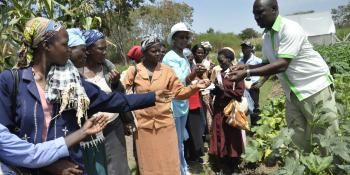Can innovative communications approaches help farmers adapt to climate smart agriculture?

At a recently held climate change workshop in Nairobi, scientists discussed how to use communications and ICTs to reach thousands of rural farmers with new farming technologies while supporting a long-term behaviour change.
“How do we achieve agricultural development in the urgent context of climate change? This question has been challenging for researchers, policy makers, agricultural experts and small scale farmers for some time now,” explained Science Officer Dr. Christine Jost to gathered workshop participants listening intently. In order to succeed, “we need to move beyond expert approach to consultative approach in order to understand our priorities, she continued”

Christine Jost giving a presentation at a recently held climate change workshop in Nairobi, Kenya. Photo: T. Mburu
Innovative communication approaches
Together with Dr. Patti Kristjanson, Theme Leader of Linking Knowledge with Action research theme, Christine Jost gave a presentation entitled “Tackling Innovation in Climate Change Research” to an intrigued audience.
"In order to address climate change, we need to tackle its complexity. Working with innovative communications strategies is our strategy at CCAFS. We work with established ICT companies that can help us disseminate climate smart change information,” Christine said.
One of these communications strategies is working with the Shamba Shape Up television program in Kenya. This partnership has been effective in disseminating climate change and agriculture information and research produced by the CGIAR Research Program on Climate Change, Agriculture and Food Security (CCAFS) and other CGIAR programs, to small-scale farmers
“In the last season of Shamba Shape Up 89 percent of viewers reported that they had learnt new things on climate smart agriculture. Through our collaboration we are reaching a lot of people with climate smart information,” Christine continued.
All stories from our Shamba Shape Up partnership can be found on our blog.
Farmer led processes of research and innovation
Patti Kristjanson mentioned that we can supplement innovative communication strategies with farmer led processes of research and innovation in agriculture. In this strategy we can insert research in development processes and strengthen capacities to innovate and adapt. So, have farmer-led processes of research and innovation in agriculture led to improvements in rural livelihoods?
“We are have been facing challenges in reaching the poorest households and the women headed ones…because innovations are not magic bullets that can be scaled up. Instead what is applicable is the approach, the process, and supporting farmer led experimentation,” explained Kristjanson.
Social learning approaches
Apart from using farmers led approaches Dr. Kristjanson points out that we can use social learning approaches. Question is, under what conditions are social learning approaches effective?
“We have developed a conceptual framework that will allow us to look at case studies from all over the world” said Kristjanson and “if research is genuinely to result in beneficial changes in behavior, policies and institutions, research outputs need to be much better informed by and engaged with the processes through which individuals, communities and societies learn and adapt their behavior in the face of change,” she said.
Read new article related to social learning: A Catalyst toward Sustainability? Exploring Social Learning and Social Differentiation Approaches with the Agricultural Poor
Using Participatory Action Research to achieve a more food secure future
Participatory Action Research (PAR) can also be used to achieve agricultural development explained Dr. Jost. PAR is a methodology in agriculture that links communities and experts to test potential solutions to problems in realistic local settings:
“There has been lots of ‘participatory’ research going on… but these studies have been largely diagnostic in nature,” Patti added.
Participatory approaches are powerful tools that can be used to understand institutional aspects, control over, access to, and use of resources and what is needed in improving solutions to a community’s most pressing agricultural problems.
However women are facing more constraints than men in adapting to participatory approaches, and farmer-led processes of research:
“We need to think about catalyzing gender institutional changes because this initiative will be key in achieving more impacts,” said Patti. “We are going to have more impact if we target women…because women are less likely to be aware of climate smart agricultural practices. But when they are aware they more likely to adopt to climate smart practices.”
For more information about our gender work please visit our dedicated gender page.
Timothy Muthee works as a Communications Intern with the theme Linking Knowledge with Action, based at the World Agroforestry Centre (ICRAF) in Nairobi, Kenya. Story edited by Cecilia Schubert, Communications officer.



